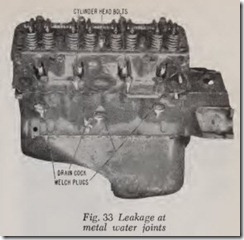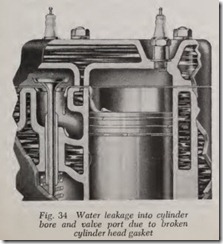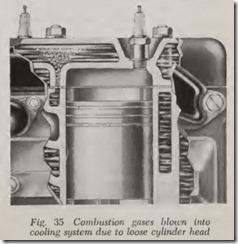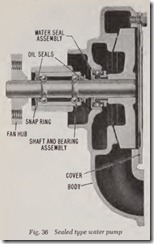Preventive Maintenance
WATER LEVEL
The level of the water in the radiator is the starting point for proper cooling system preven tive maintenance. Water level should be checked accurately and frequently for three reasons: ( 1) To make sure the system contains enough water; ( 2) as a guide to the condition of the cooling system; ( 3) to avoid overfilling.
If rust is to be avoided, it is important to make sure that the system contains a sufficient quantity of water at all times. Low water level may prevent proper circulation, especially at low engine speeds. At higher engine speeds, low water level allows a large volume of air to become mixed with the liquid. Air bubbles in the water not only reduce the capacity of the water to carry away heat, but also promote rapid rust formation and corrosion, and may cause excessive foaming and water loss out of the overflow pipe. In any case, water shortage leads to overheating, operating difficulties and engine damage.
If possible, the water level should be checked at approximately the minimum safe operating tem perature, since the level rises as the engine warms up and falls as the engine cools down. And if the cooling system is clean, leak-proof and in proper working order, very little water should be lost through evaporation or any other cause. There fore, any unusual amount of water needed to bring the level up to the standard height should be regarded as a possible indication of trouble developing in the cooling system.
If the radiator is continually filled above the proper level, any changes in the level or the quantity of water additions will be of little value as an indication of the condition of the cooling system. Both water and anti-freeze expand when heated, and if there is not enough air space left in the radiator for this expansion, some liquid will be lost through overflow. If the system contains a corrosion inhibitor, it will become diluted and weakened if overfilling is practiced.
Unnecessary additions of water increase water scale deposits which interfere with removal of heat from the engine. Overfilling also wast es anti freeze, and when a system containing anti-freeze is overfilled with water, it may lead to a freeze-up.
When necessary to add water when the engine is cold, it is enough to cover the top of the tubes by inch.
LEAKAGE
Engine vibration, road shocks and deterioration of gaskets, as well as wear, breakage or corrosion of metal parts, may create leakage. If the car is equipped with a radiator pressure cap, it creates additional pressure in the system, thereby increas ing the leakage tendency at hose connections and other water joints.
Small leaks which show dampness or even drip ping when the water is cold may not be noticed when the engine is hot, due to rapid evaporation of the liquid. Rusty or grayish-white stains at joints in the radiator or engine water jackets are usually indications of leakage, even though there appears to be no dampness. Even small leaks should not be neglected since they often become larger, someti(lleS suddenly, and generally while the car is being driven.
Radiator Leakage
Engine vibration and road shocks put a strain on all radiator seams and joints that may lead to breaka ge and leakage, particularly in the water tubes, the tanks and the inlet and outlet fittings, Fig. 30. A dditional strain is set up by extreme changes in metal temperatures, especially during cold weather operation. Neglect of small leaks may result in excessive leakage, rust clogging and overheating difficulties. Thus it is extremely im portant to keep the radiato_r mounting properly adjusted and tight at all times, and to detect and correct promptly even the smallest leaks.
The primary function of the radiator is to trans fer heat efficiently from the water to the air. This is not possibl e without clean, straight air fins and unobstructed air passag es. Air fins are easily bent and damaged by impact of small stones and other accidental causes. Flying mud, dust, sand, grass, leaves, large insects , paper and other debris, Fig. 31, may clog air passages in a very short time.
The probl em of maintaining sufficient air flow through the radiator is often complicated by fog lamps, licens e plat es, bumper guards and other assess ories placed in front of the radiator. If an accessory is mounted so that it is causing over heatin g, it should be placed elsewhere or removed entirely.
Hose Leakage
Leaks are more common at radiator hose con necti ons than anywhere else in the cooling system.
Engin e vibration has a tendency to wear and loosen hose connections . Clamps ma y buckle the hose and threads on the clamp bolts are often stripped.
The hose itself has a limited service life. Heat and water cause hose swelling, hardening, crack ing and rotting. Deterioration of hose usually takes place more rapidly from the inside, Fig. 32, so that outside inspection is not dependable. Hard ening of old hos e increases the difficulty of keeping connections leakproof . Hose failures not only result in leakage but m ay also cause restric tion of water circulation through clogging or col-lapsing . Rubber particles from rotted hose linings will clog radiator water tubes and are very diffi cult to remove. Rotted hose may break open with out warning and cause sudden large water losses. Frequent outside examination of all hose and connections and careful inside inspecti on of rubber hose whenever the connections are opened require little time and can save much trouble.
Water Jacket Leakage
The engine water jacket has gasketed water joints and a number of metal water join ts in both the cylinder head and block where preven tive maintenance neglect may result in leakage. Vibra tion, pressure, and wide changes in engine tem perature impose strains on all these joints. Gaskets deteriorate from the effects of heat, water and pressure. Gasket joints at the thermostat housing and water pump mounting are common points of leakage. Metal joints, Fig. 33, such as core hole plugs, drain plugs, drain cocks, tempera ture gauge fittings, and connections at water bypass tubes, are all subject to leakage.
Corrosion leakage occasionally develops inmetal water joints. Any leakage at water jacket j oints or casting cracks is aggravated by pump pressures, which may run as high as 35 pounds per square inch. Pump pressures are naturally greater at higher engine speeds and while the thermostat is closed. The radiator pressure cap (if fitted) also allows additional pressure to build up to prevent the coolant from boiling.
Cylinder Head Joint Leakage
The joint between the cylinder head and engine block actually consists of a large number of indi vidual water joints at water transfer ports, which are all sealed by the cylinder head gasket. All of these joints are subjected to the strain of extreme temperature changes within the engine, and also to combustion pressures as high as 600 pounds per square inch. Internal leakage at the cylinder head gasket cannot be detected from outside in spection.
Leakage of water into the engine interior, Fig.34, can cause serious damage, especially in cold weather. Either water or anti-freeze solution, when mixed in large quantities with engine oil will form sludge which may cause lubrication difficulties. If internal leakage is not promptly discovered and corrected, serious engine damage can result. 1Even though the joint is tight enough to prevent liquid leakage, the slightest looseness will allow combustion gases to be blown into the cooling system, Fig. 35. This can force water out of the overflow pipe. Burned gases dissolve in the water to form acids which cause rapid rust forma tion and attack othermetal parts.
Considering the many possible points of leakage in the cylinder head joint and the seriousness of water leakage into the engine, it is imperative that the cylinder head always be kept leakproof. Cylin der head bolts cannot be evenly tightened with an ordinary wrench. The use of a torque wrench is necessary to obtain proper uniform pressure on all bolts and to avoid warpage of the head or distor tion of the block at valve seats and cylinder bores from overtightening. The extreme importance of m aintaining cylinder head joint tightness demands careful attention to all instructions on the installa tion of new gaskets, proper order of tightening bolts, correct torque to apply, and rechecking torque following a new gasket installation.
Water Pump Leakage
The water pump is the only power-driven unit in the cooling system. Maximum pump speed of 5,000 rpm is not uncommon. Some pumps circu late more than 7,500 gallons of water an hour. Pumping failures are often caused by broken or loose drive belts, but edge wear of impeller blades and wear of the pump housing also reduce pump ing capacity.
Sand, rust and other abrasive foreign matter in the coolant have a tendency to wear away impeller blades. Corrosion of the impeller and housing may result from failure to use corrosion inhibitor with water or to discard rusty anti-freeze solution.
Leakage of the pump is a more common trouble than pumping failure. The pump housing joint is under strain from the pump drive and may work loose and leak if the mounting bolts are not kept tight.
In the sealed-type ( packless) pump, Fig. 36, the self-adjusting seals are subject to wear, de terioration and leakage. Thrust seal washers and seats are prematurely worn by abrasive action of sand, dirt and rust in the cooling water and by operation with engine overheating. Bearing and shaft damage, which leads to leakage and pump failure, can result from neglect of lubrication in pumps that require it. But over-lubrication, especially with a high pressure gun, forces grease into the cooling system, which contributes to clogging and overheating.
Forced water circulation is so necessary in the modern cooling system that any reduction in pumping capacity causes a loss of cooling effec tiveness. Complete pumping failure is invariably followed by sudden overheating and operating difficulties.
Loss of water is not the only trouble that can result from a water pump leak. Water leakage at the shaft, if not properly corrected, will destroy lubrication and cause corrosion and wear of the shaft and bearings. Even a slight leak at the pump seal or in the connections betw een the pump and radiator will allow air to be sucked into the cool ing system at high engine speeds, Fig. 37. Air suction into the system through a perforated rubber shaft seal can force enough liquid out of the overflow pipe t<Y cause serious water shortage in a short period of high speed engine operation.
Mixing of air with water (aeration) reduces heat transfer and may raise engine temperature high enough to cause overheating at high engine output. Furth ermore, the introduction of air into the system may speed up rusting as much as 30 tim es and also greatly increase corrosion of all cooling system metals. Clogging and corrosion go hand in hand with neglected water pump leakage and air suction.
THERMOSTAT
The function and operation of the thermostat is such that this unit does not have an indefinite service life and can fail with little or no advance warning. The valve and operating mechanism is subject to extreme temper ature changes, corrosion and also to wear and bending movement. Rust or foreign matter in the cooling water interferes with proper thermostat operation , and overheating from any cause may damage it.
The automatic control of engin e operating temperatures provided by the thermostat is absolutely necessary-winter and summer-for efficient engine performance. If the valve fails to close prop erly the engine will run too cool; then sludge formation and other harmful eff ects of overcooling can take place. If the valve f ails to open properly, engine temperature will ris e and overheating diffi culti es may follow. Engin es should not be oper ated with th e thermostat remov ed except in cases of emergency , and then for only as short a time as necessary to obtain a new one.
The temperature gauge should be observed during engine warm-up and on road tests in order to be sure the thermostat is functioning properly. Whenever the gauge continually indicates unsafe low or high temperatures, the thermostat should be removed and tested, as described later on.
FAN BLADES AND BELTS
Bent fan blades or a loose, bent, misaligned or damaged fan shroud, interferes with proper air flow and reduces cooling. Periodic inspection and servicing of the fan and shroud (if equipped) is essential to proper engine cooling.
Preventive maintenance of the fan drive belt is also of great importance because this belt usually drives the fan, water pump and generator. Con tinuous flexing, friction and heat cause fan belt cracking, fraying, wear and deterioration.
Loose adjustment may result in slippage, rapid belt wear and an overheated engine. Overtight adjustment also wears the belt and causes early failure of shafts and bearings in the fan, water pump or generator.
A neglected fan belt may break without warn ing and cause sudden overheating and operating difficulties. Therefore, inspection of the fan belt condition and adjustment should never be ne glected. Close examination is necessary to dis cover small flaws, particularly since belts usually begin to crack through from the inside. Immediate replacement of a doubtful belt is good insurance against car failure during operation.
RADIATOR PRESSURE CAP
A radiator pressure cap has more effect on cooling system operation than is generally real ized. A properly operating pressure cap increases the normal margin of safety between water oper ating temperature and boiling point five degrees or more. This additional margin of safety helps to prevent boiling during operation in hot weather, at high altitudes and when driving under heavy
load.
The pressure cap is subjected to high cooling temperatures which cause relatively rapid deterio . ration of the gasket. The valves and the underside of the cap are exposed to the extremely corrosive effects of hot steam and air in the upper radiator tank. Since the cap is located above the normal liquid level, it receives little protection from rust inhibitors in the cooling water, with the result that the cap and valves may fail from corrosion dam age. Even a small amount of rust scale or dirt will interfere with the operation of the pressure and vacuum valves.
Frequent removal and replacement of the cap for water level observation increases the possibil ity of leakage and pressure loss, due to wear of the gasket and cap locking mechanism.
An air leak above the liquid level in the radi ator, such as at tl1e cap gasket or pressure valve, will prevent pressure from building up, and the benefits of the pressure cap will be lost. Water may boil in some cooling systems even at normal operating temperatures if the cap is not pressure tight. If the pressure valve fails to open, sufficient pressure may build up in the system to break radiator seams or blow off hose connections. Fail ure of the vacuum valve to open when the system cools may cause collapse of hose and other parts which have no internal support.
To avoid damage to the cap gasket and gasket seat on the filler neck, care should be exercised in removing and replacing the cap. The cap should be turned to the “vent” position before removing to allow escape of hot steam that might cause personal injury. ‘
When filling the radiator, metal filling spouts or nozzles should not be allowed to come in contact with the filler neck gasket seat. Proper mainte nance consists of inspection of the cap, seat and gasket, periodic cleaning of the cap and valves, checking of valve operation, and testing for tight ness of valves and cap seal.







